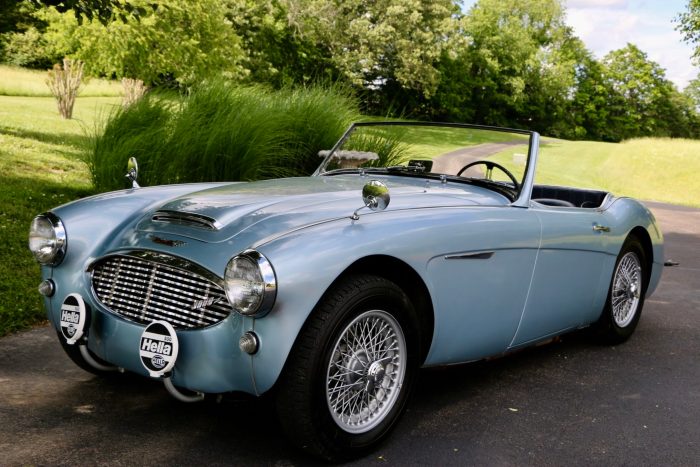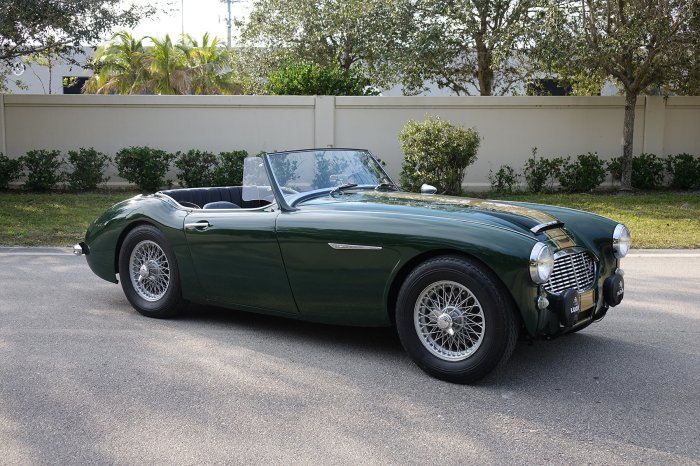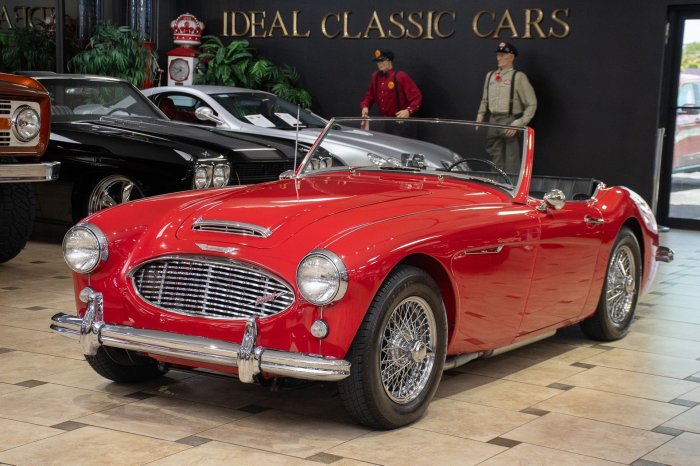The 1960 Austin-Healey 3000 Mark I, a British sports car icon, burst onto the scene in 1959, capturing the hearts of enthusiasts worldwide. This second generation of the iconic Healey 100, marked a significant evolution in both design and performance.
The Mark I, with its sleek lines, powerful engine, and agile handling, quickly became a symbol of British automotive excellence and a worthy successor to the legendary Healey legacy.
Built on the success of its predecessors, the Mark I featured a refined chassis and a more powerful 3-liter straight-six engine, capable of pushing the car to speeds exceeding 100 mph. Its distinctive design, with its low-slung body and distinctive grille, made it a standout on the road and a favorite on the racetrack.
The Mark I’s popularity was further solidified by its participation in motorsport, where it achieved notable successes in both domestic and international competitions.
History and Evolution

The Austin-Healey 3000 Mark I, a British sports car icon, emerged from a lineage of performance vehicles and a collaboration between two automotive giants. It represented a significant step forward in the evolution of the Austin-Healey brand, building upon the successes of its predecessors while introducing innovative design and engineering elements.The development of the Austin-Healey 3000 Mark I can be traced back to the Austin Motor Company and the Donald Healey Motor Company.
In 1952, the two companies joined forces to create the Austin-Healey 100, a groundbreaking sports car that achieved immediate success. The 100, powered by a 2.6-liter Austin engine, established the foundation for the future Austin-Healey models.
Design and Engineering Innovations
The Austin-Healey 3000 Mark I, launched in 1959, represented a significant leap forward in performance and refinement compared to its predecessors. The Mark I was equipped with a larger 2.9-liter inline-six engine, producing 124 horsepower, making it a formidable competitor in the sports car market.The Mark I’s chassis was designed for enhanced handling and stability.
The suspension featured independent front suspension and a live rear axle with semi-elliptic leaf springs. The car’s lightweight construction and aerodynamic bodywork contributed to its impressive performance.
Key Individuals and Companies
The development and production of the Austin-Healey 3000 Mark I involved a team of talented individuals and companies. Donald Healey, the visionary behind the Austin-Healey brand, played a pivotal role in shaping the car’s design and performance.The Austin Motor Company provided the engine and chassis, while the Donald Healey Motor Company handled the bodywork and assembly.
The Mark I’s success was also attributed to the contributions of engineers and designers at both companies, who worked tirelessly to create a truly exceptional sports car.
Design and Styling

The Austin-Healey 3000 Mark I, launched in 1959, was a striking departure from its predecessor, the 100/4. It represented a sophisticated evolution in design, blending performance and elegance in a way that captivated the hearts of enthusiasts. The Mark I’s styling, born from a collaboration between Donald Healey and BMC’s design team, was a testament to the era’s burgeoning passion for sports cars.
Bodywork and Chassis
The Mark I’s bodywork was characterized by its flowing lines and graceful curves. The long, low hood, sloping windshield, and prominent front grille created a sense of speed and aggression. The use of a monocoque chassis, a design feature borrowed from the aircraft industry, provided exceptional rigidity and contributed to the car’s handling prowess.
This innovative construction method, combined with a lightweight tubular frame, ensured a strong and nimble platform for the powerful engine. The distinctive “ducktail” rear end, a signature feature of the Mark I, further enhanced its aerodynamic profile and added a touch of sporty elegance.
Design Philosophy and Influences
The design philosophy behind the Mark I was rooted in the desire to create a car that was both beautiful and capable. The design team drew inspiration from contemporary sports cars like the Jaguar XK150 and the Mercedes-Benz 300 SL Gullwing, aiming to achieve a similar level of sophistication and performance.
The 1960 Austin-Healey 3000 Mark I, with its sleek lines and powerful engine, was a true icon of the era. While the Mark I was a testament to classic British sports car design, the later models saw significant evolution. The 1967 Austin-Healey 3000 Mark III , for example, introduced a more modern look and improved performance.
However, the Mark I remains a cherished classic, embodying the spirit of a bygone era of automotive excellence.
The Mark I’s styling was also influenced by the burgeoning American sports car market, with its emphasis on sleek lines and powerful engines.
Comparison with Other Contemporary Sports Cars
Compared to other contemporary sports cars of its era, the Austin-Healey 3000 Mark I stood out for its elegant yet sporty design. While the Jaguar XK150 offered a more luxurious and refined aesthetic, the Mark I emphasized a more aggressive and driver-focused approach.
The Porsche 356, with its compact and nimble design, was a formidable competitor, but the Mark I offered a more spacious and comfortable interior.
Performance and Handling

The Austin-Healey 3000 Mark I was a sports car designed for spirited driving, and its performance and handling characteristics reflected this intent. It was powered by a robust engine, had a well-balanced chassis, and a responsive steering system that made it a joy to drive on winding roads.
Mechanical Specifications
The Mark I was equipped with a 2.6-liter inline six-cylinder engine that produced 100 horsepower. This engine was coupled to a four-speed manual transmission, which sent power to the rear wheels. The car featured a suspension system that consisted of independent front suspension with coil springs and wishbones, and a live rear axle with semi-elliptic leaf springs.
The braking system consisted of drum brakes on all four wheels.
Performance Capabilities
The Mark I’s performance was respectable for its time. It could accelerate from 0 to 60 miles per hour in around 12 seconds and reach a top speed of approximately 100 miles per hour. The car’s handling was also commendable, thanks to its well-balanced chassis and responsive steering.
It was known for its ability to corner with precision and stability.
Driving Experience
The Austin-Healey 3000 Mark I offered a rewarding driving experience. Its engine was smooth and powerful, and the transmission was precise and easy to shift. The car’s handling was sharp and predictable, making it fun to drive on winding roads.
However, the Mark I’s ride could be a bit harsh, especially on rough roads. Additionally, the brakes were not as effective as those found on some of its contemporaries.
Production and Significance

The Austin-Healey 3000 Mark I, produced from 1959 to 1961, marked a significant chapter in the history of British sports cars. Its production, spanning just three years, saw a multitude of model variations and special editions, each contributing to its lasting legacy.
The Mark I’s impact on the automotive industry was profound, shaping the design and performance of sports cars for decades to come.
Production History
The Austin-Healey 3000 Mark I’s production run was relatively short, but it was marked by several notable variations. The car was initially available in two versions: the “100/4” and the “100/6.” The “100/4” was powered by a 2.6-liter four-cylinder engine, while the “100/6” featured a 2.9-liter six-cylinder engine.
The “100/6” was the more popular of the two, and it was further refined with the introduction of the “100/6 Mk II” in 1960. This version featured a number of improvements, including a larger fuel tank, revised suspension, and a more powerful engine.
In addition to the standard models, several special editions of the Austin-Healey 3000 Mark I were produced. These included the “Le Mans” edition, which was designed for racing, and the “BT7” edition, which was a lightweight roadster. The “BT7” was a more hardcore version, designed for racing, with a shorter wheelbase and a lightweight body.
It was not as widely produced as the other models.
- 100/4:The “100/4” was the first version of the Austin-Healey 3000 Mark I, and it was powered by a 2.6-liter four-cylinder engine. It was offered in both roadster and coupe body styles.
- 100/6:The “100/6” was the more popular version of the Austin-Healey 3000 Mark I, and it was powered by a 2.9-liter six-cylinder engine.
The 1960 Austin-Healey 3000 Mark I, a classic British sports car, offered a blend of performance and elegance. While the 3000 Mark I was a larger, more luxurious model, it shared a lineage with the smaller and more agile 1966 Austin-Healey Sprite.
Both cars embodied the spirit of British sports car engineering, capturing the hearts of enthusiasts with their distinctive styling and driving experience. The 3000 Mark I, with its powerful engine and refined handling, continued to be a popular choice for those seeking a thrilling yet comfortable ride.
It was offered in both roadster and coupe body styles.
- 100/6 Mk II:The “100/6 Mk II” was introduced in 1960, and it featured a number of improvements, including a larger fuel tank, revised suspension, and a more powerful engine.
- Le Mans:The “Le Mans” edition was designed for racing, and it featured a number of performance upgrades, including a more powerful engine, a lighter body, and a revised suspension.
- BT7:The “BT7” edition was a lightweight roadster that was designed for racing. It was produced in limited numbers and was not as widely available as the other models.
Impact on the Automotive Industry
The Austin-Healey 3000 Mark I’s influence on the automotive industry was significant. The car’s combination of style, performance, and affordability made it a popular choice for both enthusiasts and everyday drivers. The Mark I’s success helped to establish the British sports car as a force to be reckoned with on the global stage.
It was also a significant influence on the development of the sports car in general. Its lightweight construction, powerful engine, and sporty handling became the blueprint for many sports cars that followed.
Cultural and Social Significance
The Austin-Healey 3000 Mark I was more than just a car; it was a cultural icon. It was featured in numerous films and television shows, and it became a symbol of the British sporting spirit. The Mark I was a popular choice for celebrities and royalty, and it was often seen at sporting events and social gatherings.
The Austin-Healey 3000 Mark I was also a successful racing car. It competed in numerous events, including the Le Mans 24 Hours, and it achieved several notable victories. The car’s success in motorsport further cemented its status as a legend.
The Austin-Healey 3000 Mark I was a car that captured the imagination of a generation. It was a symbol of freedom, adventure, and style.
Notable Owners and Events: 1960 Austin-Healey 3000 Mark I

The Austin-Healey 3000 Mark I attracted a diverse range of owners, from celebrities and racing drivers to everyday enthusiasts. The car’s combination of style, performance, and affordability made it a popular choice for those seeking a thrilling driving experience.
These owners and the events they participated in played a significant role in shaping the Mark I’s legacy.
The 1960 Austin-Healey 3000 Mark I, with its distinctive chrome grille and rounded bodywork, quickly established itself as a classic sports car. Three years later, the 1963 Austin-Healey 3000 Mark II arrived, featuring a more angular design and a powerful six-cylinder engine.
However, the Mark I, with its timeless elegance and undeniable charm, remains a highly sought-after collector’s item.
Notable Owners and Events
The Austin-Healey 3000 Mark I was driven by a number of notable individuals, and was involved in a variety of significant events. The following table lists some of the more prominent owners and events associated with the Mark I:
| Owner Name | Occupation | Event Name | Description |
|---|---|---|---|
| Steve McQueen | Actor | Le Mans 24 Hours | McQueen, a renowned Hollywood star and car enthusiast, famously raced a 3000 Mark I at Le Mans in 1962. Although he did not finish the race, his participation added to the car’s mystique. |
| Sir Stirling Moss | Racing Driver | Various Races and Rallies | One of the greatest racing drivers of all time, Moss achieved numerous victories and podium finishes in his 3000 Mark I. He also competed in the car in rallies like the Alpine Rally and the RAC Rally. |
| Carroll Shelby | Racing Driver and Automotive Designer | Development of the Cobra | Shelby, known for his iconic Cobra sports car, initially used the Austin-Healey 3000 Mark I as a basis for his own high-performance roadster. He later collaborated with AC Cars to create the Cobra, which used a powerful Ford V8 engine. |
| James Dean | Actor | “Rebel Without a Cause” | The iconic actor was a passionate car enthusiast and was often seen driving his 3000 Mark I. He was even featured in the film “Rebel Without a Cause” with his car. |
Restoration and Preservation

Restoring and preserving an Austin-Healey 3000 Mark I is a labor of love, demanding both technical expertise and a deep appreciation for the car’s heritage. The process can be challenging, requiring patience, meticulous attention to detail, and a willingness to invest significant time and resources.
However, the rewards are immense, culminating in the satisfaction of bringing a classic car back to its former glory.
Restoring a Mark I
Restoring a Mark I involves a systematic approach, encompassing a range of tasks from sourcing parts to meticulous bodywork restoration. The process can be broken down into the following steps:
- Assessment and Planning:The initial step involves a thorough assessment of the car’s condition, identifying areas requiring restoration. A comprehensive inspection is essential, including the engine, transmission, chassis, body, and interior. Based on the assessment, a restoration plan should be developed, outlining the scope of work, budget, and timeline.
- Sourcing Parts:Obtaining original or high-quality reproduction parts is crucial for maintaining the car’s authenticity and ensuring its longevity. Several sources for Mark I parts exist, including specialist suppliers, online marketplaces, and salvage yards. It’s important to research the reputation of suppliers and verify the quality of parts before making a purchase.
- Mechanical Restoration:This phase focuses on restoring the car’s mechanical components to their original specifications. It involves tasks such as engine rebuild, transmission overhaul, suspension refurbishment, and brake system restoration. A skilled mechanic with experience working on classic cars is essential for this stage.
- Bodywork Restoration:Restoring the Mark I’s bodywork is a meticulous process, requiring specialized skills and equipment. This involves removing rust, straightening dents, and applying multiple layers of primer and paint to achieve a flawless finish. Professional body shops specializing in classic car restoration are highly recommended for this stage.
- Interior Restoration:Restoring the Mark I’s interior involves reupholstering the seats, replacing worn carpets, and restoring the dashboard and instruments. Original materials or high-quality replacements are preferred to maintain authenticity. Experienced upholsterers and interior specialists can provide expert craftsmanship for this stage.
- Final Assembly and Testing:Once all the components are restored, the car is assembled, and all systems are thoroughly tested. This involves road testing to ensure the car runs smoothly and meets safety standards.
Resources for Mark I Owners
Numerous resources are available for Mark I owners seeking information and support for restoration projects. These include:
- Austin-Healey Club:The Austin-Healey Club is a global organization dedicated to preserving and promoting Austin-Healey cars. It offers technical support, parts sourcing assistance, and access to a vast network of knowledgeable members.
- Online Forums and Communities:Online forums and communities dedicated to classic cars, including the Austin-Healey 3000 Mark I, provide a platform for owners to share information, ask questions, and connect with other enthusiasts.
- Restoration Specialists:Several restoration specialists specialize in restoring Austin-Healey 3000 Mark I cars. These professionals possess the expertise and experience to handle complex restoration projects, ensuring the car is restored to the highest standards.
- Parts Suppliers:Numerous suppliers specialize in providing parts for Austin-Healey 3000 Mark I cars, offering a wide range of original and reproduction parts.
Modern Relevance and Legacy

The Austin-Healey 3000 Mark I, despite its production ending in the 1960s, continues to hold a significant place in the automotive world. Its enduring popularity and collector value are testaments to its timeless design, exhilarating performance, and undeniable British charm.
The Mark I’s influence can still be seen in modern sports car design, and it remains a cherished symbol of classic British motoring.
The Austin-Healey 3000 Mark I’s Enduring Popularity
The Mark I’s enduring popularity can be attributed to a combination of factors, including its sleek design, powerful engine, and engaging driving experience. The car’s timeless styling, characterized by its low-slung profile, flowing lines, and distinctive grille, continues to appeal to enthusiasts today.
The Mark I’s 3.0-liter inline-six engine, capable of producing over 130 horsepower, provided exhilarating performance for its time, and its nimble handling made it a joy to drive on winding roads. These qualities, coupled with its relative affordability compared to other classic sports cars, have contributed to the Mark I’s enduring popularity.
The Mark I’s Influence on Modern Automotive Design
The Austin-Healey 3000 Mark I’s influence on modern automotive design is evident in several key areas. Its low-slung profile and emphasis on aerodynamic efficiency were groundbreaking for its time and have since become hallmarks of modern sports car design. The Mark I’s distinctive grille, with its horizontal slats and prominent badge, has inspired the design of grilles on numerous modern sports cars.
The Mark I’s lightweight construction and focus on driver engagement have also influenced the design of modern sports cars, which prioritize performance and handling over sheer size and luxury. For example, the iconic Porsche 911, which debuted in 1963, shares a similar design philosophy with the Mark I, prioritizing performance and driver engagement over sheer size and luxury.
The Mark I’s Legacy as a Classic British Sports Car
The Austin-Healey 3000 Mark I holds a special place in automotive history as a quintessential British sports car. It embodies the spirit of British engineering, craftsmanship, and design, and its enduring popularity has cemented its status as a classic.
The Mark I’s legacy is further enhanced by its association with the legendary Le Mans 24 Hours race, where it achieved notable success in the 1960s. The Mark I’s influence on modern sports car design and its enduring popularity among enthusiasts have ensured its lasting legacy as a symbol of classic British motoring.
The Mark I’s Enduring Relevance, 1960 Austin-Healey 3000 Mark I
| Feature | Modern Relevance | Legacy Impact |
|---|---|---|
| Timeless Design | The Mark I’s sleek and elegant design continues to appeal to enthusiasts today. | Its design has influenced the styling of numerous modern sports cars. |
| Powerful Engine | The Mark I’s 3.0-liter inline-six engine provided exhilarating performance for its time. | The Mark I’s engine performance set a benchmark for sports cars of its era. |
| Nimble Handling | The Mark I’s nimble handling and engaging driving experience continue to be appreciated by enthusiasts. | The Mark I’s handling characteristics have influenced the design of modern sports cars. |
| Cultural Significance | The Mark I is a symbol of classic British motoring and represents a bygone era of automotive design and engineering. | The Mark I’s cultural significance has made it a sought-after collector’s item. |
Concluding Remarks

The 1960 Austin-Healey 3000 Mark I stands as a testament to British engineering prowess and the enduring allure of classic sports cars. Its legacy lives on, inspiring generations of car enthusiasts and reminding us of a time when driving was not just about transportation, but an experience to be savored.
The Mark I continues to be a sought-after collectible, with its timeless design and thrilling performance making it a prized possession for car collectors and enthusiasts alike.